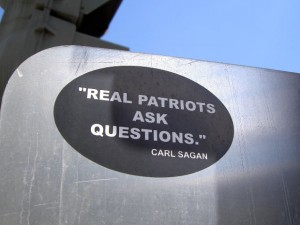 If you’ve never thought about the impact of asking questions at work in a better way, I’m going to help change that today. Consider the following list of questions you’d hear in the average day:
If you’ve never thought about the impact of asking questions at work in a better way, I’m going to help change that today. Consider the following list of questions you’d hear in the average day:
- Why do we have to go through this change?
- Why can’t we find good people?
- When will that guy do his job right?
- Why don’t they communicate better?
- Who messed this up?
- When is someone going to train me?
- When are my people going to get their act together?
Any of these questions seem familiar? We’ve all heard a version of them at some point in time. The theme running through these questions is twofold. First, there\’s a definite negative connotation. Second, and most importantly, they are structured to place blame and accountability on someone else.
That’s not a winning plan.
If you’re trying to be successful as a leader, you\’re going to have to hold people accountable. Letting them ask questions like these is a surefire way to ensure that they never learn self accountability.
It doesn’t always fit, but the majority of the time questions that begin with “who, when, and why†are potential problems. In the examples above you’ll see that play out.
The point is to turn the questions around and find ways to hold yourself accountable for the results. Try starting the questions with “how can I…†or “what can I…†and you\’ll see that the responsibility immediately shifts from someone else to you.
You’re the one in charge of making the change at that point.
It’s a radically different mindset to ask questions like these. Why? Because you have to care. And you have to be willing to hold yourself and your people accountable for the results. It isn’t easy, but it’s worth it.
Here is the same set of questions rewritten with accountability in mind:
- What can I do to make this change easier on others?
- How can I help us find better people?
- What can I do to help that guy do his job better?
- How can I help to strengthen communication?
- How can I make this right?
- What can I do to pursue training?
- How can I help my people be better at their jobs?
Foster a culture of accountability with your people and reap the benefits of stronger individual and team performance.
Finally, here’s a great example of how one company does this on a daily basis.
WD-40 practices the democratic principle of Accountability. To that end we ask every tribe member to own and act passionately on the Maniac Pledge. The pledge states: “I am responsible for taking action, asking questions, getting answers, and making decisions. I won’t wait for someone to tell me. If I need to know, I’m responsible for asking. I have no right to be offended that I didn’t ‘get this sooner.’ If I’m doing something others should know about, I’m responsible for telling them.” Source: WD-40
Challenge: Can you choose a question from the list above and put it into motion today? If so, which one did you pick?
 Have you ever thought about company success stories? Most of us are captivated by the startup company “started in a garage and became a millionaire” type stories. I wasn’t looking for an object lesson, but I found one in an interesting place.
Have you ever thought about company success stories? Most of us are captivated by the startup company “started in a garage and became a millionaire” type stories. I wasn’t looking for an object lesson, but I found one in an interesting place. When you’re trying to learn about an organization’s corporate culture, values, and  beliefs, you need to pay attention to the available information to get a good feel for it. One of my friends is looking at applying to a local private Christian school, and I went to their website to
When you’re trying to learn about an organization’s corporate culture, values, and  beliefs, you need to pay attention to the available information to get a good feel for it. One of my friends is looking at applying to a local private Christian school, and I went to their website to 